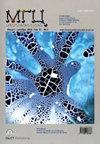酞菁锌与甲基卟啉共价连接二偶体的合成及理化研究
IF 1.2
4区 化学
Q4 CHEMISTRY, MULTIDISCIPLINARY
引用次数: 0
摘要
在温和条件下,甲磷化合物a中α-酮乙酯与锌(II) 2-(2-羟甲基苄氧基)-9(10)、16(17)、23(24)-三叔丁基酞菁酸酯酯酯交换得到了第一个共价连接的金属酞菁酸酯与氯6衍生物。该二偶体呈现全色性质,在紫外-可见吸收光谱中显示酞菁和酞菁衍生带。1h NMR数据结合理论计算表明,酞菁、酞菁和间隔片段之间存在空间分子内相互作用,可以预测其增强的非线性光学性质,以及从受激发的酞菁亚基到酞菁核心的特征能量转移。在UV-Vis范围内激发时,共轭物显示出红色荧光,光谱最大值在686 nm处,与最初的酞菁酸锌接近。此外,该二元体有效地产生单线态氧,并在聚乙烯吡咯烷酮(PVP)作为生物相容性增溶剂存在下,形成粒径在40至100 nm之间的稳定胶束盐水溶液。这些纳米颗粒代表了第三代光敏系统在治疗学中的应用前景。下式:[44]S R S R甲苯f,其中G为积分发射面积,n为溶剂折射率,A λ为激发波长处的吸光度,Φ f为荧光量子产率。指标S和R分别对应样本和参考文献。在新鲜制备的含甲苯溶液中测量了单线态氧(o2)的量子产率(Φ Δ)本文章由计算机程序翻译,如有差异,请以英文原文为准。
A Covalently Linked Dyad Based on Zinc Phthalocyanine and Methylpheophorbide a: Synthetic and Physicochemical Study
The first covalently linked conjugate of metal phthalocyaninate and chlorin e 6 derivative has been obtained by transesterification of α-ketomethyl ester in methylpheophorbide a with zinc(II) 2-(2-hydroxymethylbenzyloxy)-9(10),16(17),23(24)-tri-tert-butylphthalocyaninate under mild conditions. The dyad exhibits a panchromatic nature revealing both the phthalocyanine and pheophorbide derived bands in the UV-Vis absorption spectrum. The 1 H NMR spectroscopy data combined with theoretical calculations indicate the presence of spatial intramolecular interactions between the phthalocyanine, pheophorbide and spacer fragments of the dyad allowing to forecast its enhanced nonlinear optical properties, as well as the characteristic energy transfer from the excited pheophorbide subunit to the phthalocyanine core. Indeed, when excited in the UV-Vis range, the conjugate shows red fluorescence with the spectral maximum at 686 nm, which is close to the one of the initial zinc phthalocyaninate. Furthermore, the dyad effectively generates singlet oxygen and, in the presence of polyvinylpyrrolidone (PVP) as biocompatible solubilizer, forms stable micellar saline solutions with the particles ranged in size between 40 and 100 nm. These nanoparticles represent promising third-generation photosensitizing systems for application in theranostics. lowing equation: [44] S R S R toluene f where G is the integrated emission area, n is the refractive index of the solvent, A λ is the absorbance at the excited wavelength, and Φ f is the fluorescence quantum yield. The indexes S and R correspond to the sample and the reference, respectively. The singlet oxygen ( 1 O 2 ) quantum yields ( Φ Δ ) were mea sured in freshly prepared solutions in toluene containing
求助全文
通过发布文献求助,成功后即可免费获取论文全文。
去求助
来源期刊

Macroheterocycles
CHEMISTRY, MULTIDISCIPLINARY-
CiteScore
2.30
自引率
21.40%
发文量
0
期刊介绍:
The journal is a forum for the specialists investigating macroheterocyclic compounds. It publishes original experimental and theoretical works (full papers and short communications) and reviews on synthesis, structural characterization, physical and coordination chemistry as well as practical application of macroheterocycles.
 求助内容:
求助内容: 应助结果提醒方式:
应助结果提醒方式:


